Steinberg HALion Sonic SE 3 Operation Manual

Operation Manual
Matthias Klag, Michael Ruf
Cristina Bachmann, Heiko Bischoff, Christina Kaboth, Insa Mingers, Matthias Obrecht, Sabine Pfeifer, Benjamin Schütte, Marita Sladek
This PDF provides improved access for vision-impaired users. Please note that due to the complexity and number of images in this document, it is not possible to include text descriptions of images.
The information in this document is subject to change without notice and does not represent a commitment on the part of Steinberg Media Technologies GmbH. The software described by this document is subject to a License Agreement and may not be copied to other media except as specifically allowed in the License Agreement. No part of this publication may be copied, reproduced, or otherwise transmitted or recorded, for any purpose, without prior written permission by Steinberg Media Technologies GmbH. Registered licensees of the product described herein may print one copy of this document for their personal use.
All product and company names are ™ or ® trademarks of their respective owners. For more information, please visit www.steinberg.net/trademarks.
© Steinberg Media Technologies GmbH, 2017. All rights reserved.

Table of Contents
4 Installation
4Conventions
5System Requirements
6Installing the Program
6How You Can Reach Us
6About the Documentation
7Setting Up
8Introduction
8 Window Overview
10 Common Editing Methods
10 Buttons
10Value Fields
11Using Key Commands
11 Presets
13 Global Functions and Settings
13 Plug-in Functions Section
15 Plug-in Name and Steinberg Logo
15Toolbar
16Performance Controls
16Quick Controls
17Trigger Pads
19 Options Page
24 Managing Your Sounds
24About Programs, Multis, and Presets
24Loading Programs
25Slot Rack
26Managing and Loading Files
31 |
Editing Programs |
31 |
Macro Page |
33 |
Trip Macro Page |
43 |
Automation |
43 |
Automation Page |
43 |
Setting Up Automation |
45MIDI Editing and Controllers
45MIDI Page
46MIDI Controllers
49Mixing and Effect Handling
49Mix Page
50Effect Handling
52 Library Manager
52 Library Manager Editor
55 Effects Reference
55 Reverb Effects
59Delay Effects
60EQ Effects
62Filter Effects
70Distortion Effects
75Pitch Shift Effects
75Modulation Effects
86Dynamics Effects
96Spatial and Panner Effects
97Legacy Effects
109 Using the Standalone Version of the Plug-In
109 Making Preferences Settings
109 Preferences Dialog
111Selecting the MIDI Input and the Audio Output
111 Scratch Pad
113Loading a MIDI File
114Saving a MIDI File
114Master Volume
115Index
3

Installation
Conventions
In our documentation, we use typographical and markup elements to structure information.
Typographical Elements
The following typographical elements mark the following purposes.
PREREQUISITE
Requires you to complete an action or to fulfill a condition before starting a procedure.
PROCEDURE
Lists the steps that you must take to achieve a specific result.
IMPORTANT
Informs you about issues that might affect the system, the connected hardware, or that might bring a risk of data loss.
NOTE
Informs you about issues that you should consider.
EXAMPLE
Provides you with an example.
RESULT
Shows the result of the procedure.
AFTER COMPLETING THIS TASK
Informs you about actions or tasks that you can undertake after completing the procedure.
RELATED LINKS
Lists related topics that you can find in this documentation.
4

Installation
System Requirements
Markup
Bold text indicates the name of a menu, option, function, dialog, window, etc.
EXAMPLE
In the header of the plug-in panel, click the Preset Management button next to the preset name field and select Load Preset.
If bold text is separated by a greater-than symbol, this indicates a sequence of different menus to open.
EXAMPLE
To save a specific layer, right-click it and select Load/Save > Save Layer As.
Key Commands
Many of the default key commands, also known as keyboard shortcuts, use modifier keys, some of which are different depending on the operating system.
For example, the default key command for Undo is Ctrl-Z on Windows and Cmd-Z on Mac OS. When key commands with modifier keys are described in this manual, they are shown with the Windows modifier key first, in the following way:
•Windows modifier key/Mac OS modifier key-key
EXAMPLE
Ctrl/Cmd-Z means: press Ctrl on Windows or Cmd on Mac OS, then press Z.
System Requirements
Your computer must meet the following minimum requirements:
Mac
•Mac OS X Version 10.11/macOS 10.12
•VST 3, AAX, or AU compatible host application for using HALion Sonic SE as a plug-in
•64-bit Intel or AMD mutli-core processor (Intel i5 or faster recommended)
•4 GB RAM (8 GB recommended)
•1 GB of free hard-disk space
•Display resolution of 1366 x 768 pixels (1920 x 1080 recommended)
•OS-compatible audio hardware*
•Internet connection required for activation, account setup, and personal/ product registration
•Downloads are required for the installation
*ASIO-compatible audio hardware recommended for low-latency performance
5

Installation
Installing the Program
Windows
•64-bit Windows 7*/8.x/10
•VST 2, VST 3, or AAX compatible host application for using HALion Sonic SE as a plug-in
•64-bit Intel or AMD mutli-core processor (Intel i5 or faster recommended)
•4 GB RAM (8 GB recommended)
•1 GB of free hard-disk space
•Display resolution of 1366 x 768 pixels (1920 x 1080 recommended)
•OS-compatible audio hardware**
•Internet connection required for activation, account setup, and personal/ product registration
•Downloads are required for the installation
*Windows 7 Service Pack 1, Microsoft.NET Framework 4.0 and Platform Update for Windows
**ASIO-compatible audio hardware recommended for low-latency performance
Installing the Program
After downloading the required files, you can install HALion Sonic SE on your computer.
•On Windows systems, double-click the product installer  and follow the instructions on screen.
and follow the instructions on screen.
•On a Mac, double-click the file HALion Sonic SE.pkg and follow the instructions on screen.
How You Can Reach Us
Click the Steinberg logo in the top right corner of the control panel to open a pop-up menu containing items for getting additional information and help.
•This menu contains links to various Steinberg web pages. Select a link to open the corresponding page. On the web pages, you can find support and compatibility
information, answers to frequently asked questions, links for downloading new drivers, etc.
•You also find a menu item for the registration of your product.
As a registered user, you are entitled to technical support, you gain access to exclusive offers such as software updates and upgrades, and more.
About the Documentation
•To visit steinberg.help, enter steinberg.help in the address bar of your web browser or open HALion Sonic SE, click the Steinberg logo in the top right corner and select Help > HALion Sonic SE Help.
6

Installation
Setting Up
Setting Up
The following sections describe how to use HALion Sonic SE as a plug-in in different host applications.
NOTE
HALion Sonic SE can also be used as a standalone application.
Using the Instrument in an AU-Compatible Application
The AU version of HALion Sonic SE is installed in your AU plug-ins folder and lets HALion Sonic SE work in an AU environment without any performance loss or incompatibilities.
For example, to load HALion Sonic SE as an AU instrument for Logic Pro, proceed as follows:
PROCEDURE
1.Open the Track Mixer and select the instrument channel that you want to use.
2.Click in the I/O field and select AU Instruments > Steinberg > HALion Sonic SE.
3.Select one of the available channel configurations.
Using the Instrument as Standalone Application
HALion Sonic SE can be used as a standalone application, independently of any host application. In this case, you can connect the instrument directly to your audio hardware.
RELATED LINKS
Using the Standalone Version of the Plug-In on page 109
7
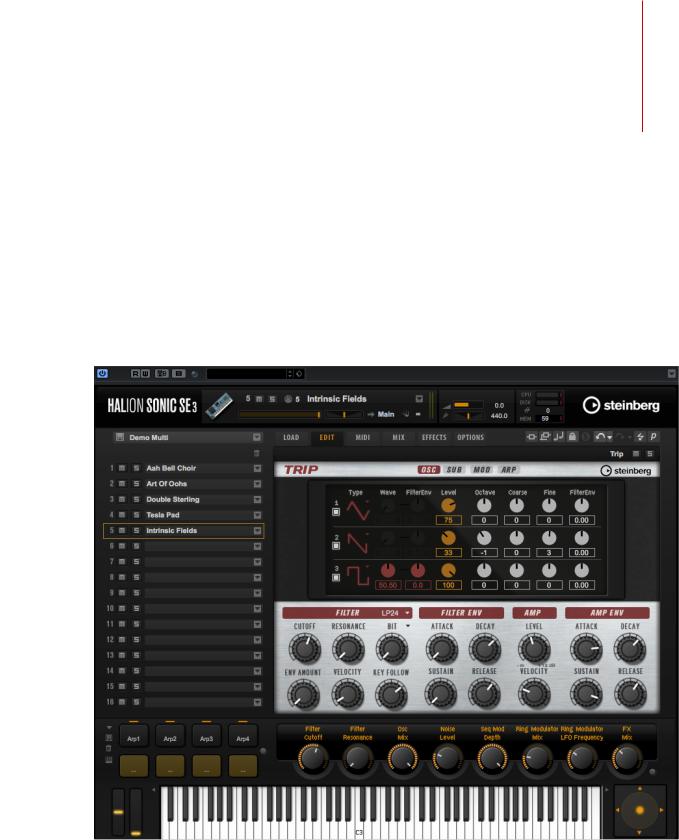
Introduction
Window Overview
The application interface follows a fixed-size single window concept.
The window is subdivided into several sections:
•The plug-in functions section at the top of the application window.
•The multi program rack on the left.
•The toolbars above the edit display.
•The edit display on the right. It contains the Load, Edit, MIDI, Mix, Effects, and Options pages.
8

Introduction
Window Overview
•The performance section at the bottom. It contains the trigger pads, the quick controls, the performance controllers, and the sphere control.
View Options
You have two view options: the full-size editor view and the smaller player view. In the player view, only the plug-in functions, the trigger pads, the quick controls, and the performance controllers are visible.
•Click the p button in the toolbar above the edit display to switch between the views. When the player view is active, the button changes to e, indicating that clicking again lets you return to the editor view.
9

Common Editing Methods
Buttons
On/Off Buttons
These buttons have two states: on and off. If you move the mouse over an On/Off button, it changes its appearance to show that you can click it.
Push Buttons
Push buttons trigger an action and then go back to their inactive state. These buttons open menus or file dialogs.
Value Fields
To set a value, you have the following possibilities:
•Double-click in a value field, enter a new value, and press Enter.
If the entered value exceeds the parameter range, it is automatically set to the maximum or the minimum value, respectively.
•Click in the value field and drag up or down.
•Position the mouse over a value field and use the mouse wheel.
•Click the up/down triangles next to the field.
•To set the parameter to its default value, Ctrl/Cmd-click the value field.
•To use a fader to adjust the value, Alt-click a value field.
•To enter musical values, such as key ranges or the root key, with your MIDI keyboard, double-click the value field, press a key on your MIDI keyboard, and press Return.
•To navigate to the next parameter, press Tab. To jump backwards to the previous parameter, press Shift-Tab.
If no parameter is selected inside the focused view, pressing Tab always jumps to the first parameter.
10
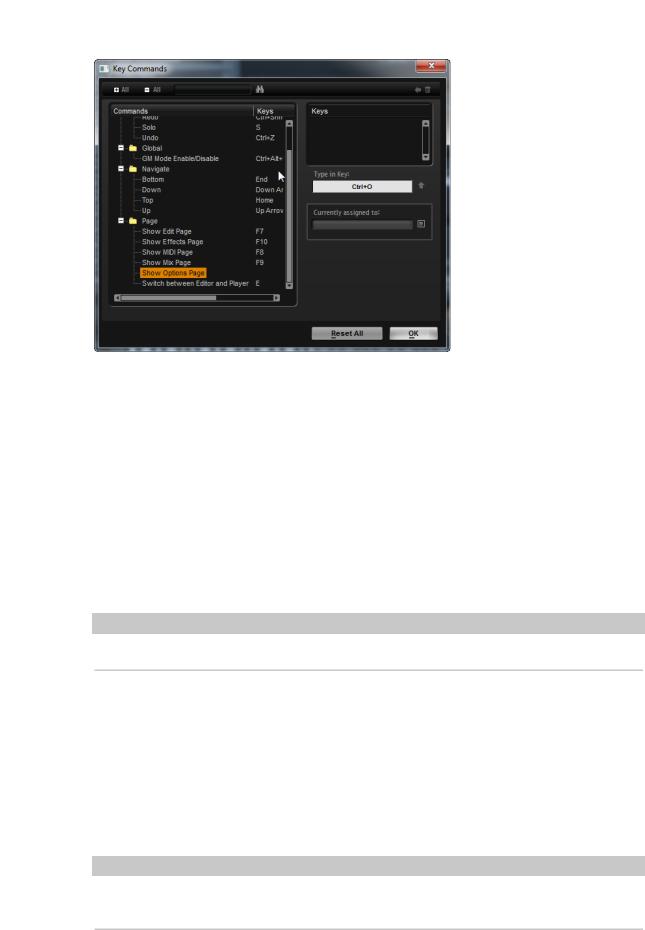
Common Editing Methods
Using Key Commands
Using Key Commands
•To open the Key Commands dialog, open the Options page and click the Key Commands button in the Global section.
The commands are arranged in a hierarchical folder structure on the left. When you open a category folder, the items and functions are displayed with any currently assigned key commands.
•To set up a key command, select the function in the list, enter the key command in the Type in Key field and click the Assign  button to the right of the field. If this key command is already used for another function, this is displayed in the field below.
button to the right of the field. If this key command is already used for another function, this is displayed in the field below.
•To delete a key command, select the function in the list, select the key command in the Keys list and click the Delete  button.
button.
•To search for a specific function, enter its name in the search field at the top of the dialog and click the search  button.
button.
NOTE
You can set up several key commands for the same function.
Presets
HALion Sonic SE offers two types of presets: section/module presets and VST presets. Section and module presets store and recall the setup of a specific component on the HALion Sonic SE panel. VST presets contain all information necessary to restore the complete state of the plug-in.
During setup, the factory presets are installed in a dedicated folder and a user folder is created for your own presets. The handling of presets is the same throughout the program.
NOTE
Factory presets are write-protected, but may be overwritten when a software update is executed. Presets in your user folder are never changed by the software update.
11

Common Editing Methods
Presets
For more information on VST presets, see the Operation Manual of your Steinberg DAW.
Handling Section and Module Presets
The preset controls can be found throughout the program. The handling is always the same.
•To save a preset, click Save  .
.
NOTE
You cannot overwrite factory presets. If you want to save changes made to a factory preset, save the preset under a new name or in a new location.
•To load a preset, click the arrow icon and select a preset from the list.
•To delete a preset, click Delete  .
.
NOTE
Factory presets cannot be deleted.
Handling VST Presets
Loading VST Presets
PROCEDURE
1.In the header of the plug-in panel, click the Preset Management button next to the preset name field and select Load Preset.
2.Do one of the following:
•Select a preset to load it.
•Double-click a preset to load it and close the preset loader.
Saving VST Presets
PROCEDURE
•In the header of the plug-in panel, click the Preset Management button next to the preset name field and select Save Preset.
12

Global Functions and Settings
Plug-in Functions Section
The plug-in functions section at the top of the window gives you access to global functions that affect both the currently loaded programs, and the general working of the plug-in.
The plug-in functions section contains the multi slot section, the program slot section, the master section, and the performance displays.
Program Slot Section
The slot parameters are the same as in the multi program rack. In addition, the following parameters are available:
Slot Number
The number of the active slot. You can switch to another slot by clicking the slot number and selecting an entry from the list.
NOTE
Only slots that contain programs are available on the list.
Load Icon
Click the Load icon to the right of the slot to open the program loader. Doubleclick a program to load it.
MIDI Activity Indicator
The MIDI symbol starts blinking when incoming MIDI data is detected.
Level
Adjusts the output level of the slot.
Pan
Adjusts the position of the slot in the stereo panorama.
Output
On the output selector, you define the output destination of the slot signal.
13

Global Functions and Settings
Plug-in Functions Section
Polyphony
Sets the number of keys that can be played simultaneously.
NOTE
One key can trigger several layers. On the performance meter, you can see how many voices are triggered by your playing.
Program Icon
The program icon indicates the sound category to which the program belongs. It depends on the category and subcategory tags that are specified for a program in the MediaBay.
Master Section
The master section can be used to set volume and tuning of the plug-in.
Master Volume
Adjusts the overall volume of the plug-in.
Master Tune
You can set the Master Tune slider from 415.3 Hz to 466.2 Hz, which equals -100 cents to +100 cents.
Performance Displays
The meters and text displays indicate the system load of the plug-in.
CPU
This meter shows the processor load during playback. The more voices you play, the higher the processor load. If the overload indicator lights up, reduce the Max Voices setting on the Options page.
Disk
This meter shows the hard disk transfer load during the streaming of samples or when loading presets. If the overload indicator lights up, the hard disk is not supplying data fast enough. In such a case, open the Options page and adjust the Disk vs. RAM slider towards RAM or decrease the Max Voices setting.
Polyphony
This display indicates the number of samples that are currently played back, to help you trace performance problems. For example, if you have to reduce the Max Voices setting on the Options page, you can verify your settings by monitoring the number of samples that are currently playing.
14

Global Functions and Settings
Plug-in Name and Steinberg Logo
Memory
This display indicates the overall amount of RAM that is currently used by the plug-in and the loaded programs. The number refers to the streaming buffer and the preloaded samples. The MEM display helps you trace performance problems. For example, if you need to free up memory for other applications, you can adjust the Disk vs. RAM slider on the Options page toward Disk. You can verify your settings by monitoring the MEM display.
Plug-in Name and Steinberg Logo
To get information regarding the version and build number of the plug-in, click the plugin logo. This opens the About box. To close the About box, click it or press Esc on your computer keyboard.
If you click the Steinberg logo in the top right corner of the plug-in interface, a pop-up menu opens. Select one of the options to navigate to Steinberg web pages containing information on software updates, troubleshooting, etc.
Toolbar
The toolbar below the plug-in functions section contains controls for loading multi-programs on the left, the buttons to switch between the different pages, and various useful global functions.
Global insert, AUX, and FlexPhraser buttons
Use these buttons to switch off all insert effects, AUX effects, and FlexPhrasers for the whole plug-in at once. You can use this to compare sounds with and without effects or to use a preset without the FlexPhrasers, for example. FlexPhrasers are a feature of the full version of HALion. They add arpeggios and even complex musical phrases to some programs of the factory content.
Lock button
If this button is activated, loading another program or layer does not overwrite the current FlexPhraser and trigger pad settings.
MIDI Reset
Click this button to stop playback and reset all MIDI controllers to their default values.
Undo/Redo
To undo or redo a single operation, click the Undo or Redo buttons. To undo or redo multiple operations, click the arrow next to the button to open the history and select the step to which you want to return.
Editor/Player
This button toggles between the two views: the full-size editor view (e) and the smaller player view (p).
15
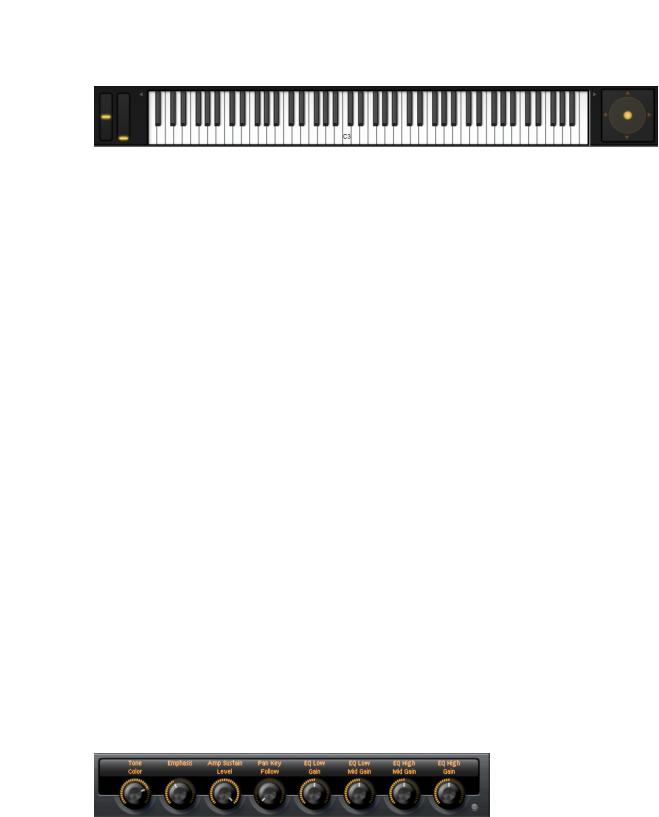
Global Functions and Settings
Performance Controls
Performance Controls
The performance controls are located in the lower part of the window.
Wheel Controls
To the left of the internal keyboard, the pitchbend wheel and the modulation wheel are located.
The modulation wheel is hardwired to MIDI controller #1, which is normally used as a source in the modulation matrix, but can be used as a quick control as well.
Keyboard
The virtual 88-note keyboard can be used to trigger MIDI notes. By clicking the keys at different vertical positions you can control the note-on velocity. Furthermore, the keyboard displays keys that are not used to trigger notes but act as key switches. The Shift Keyboard buttons to the left and right of the keyboard shift the keyboard range by octaves. This allows you to display key switches that are located on lower keys, for example.
Sphere Control
The sphere is a two-dimensional control. It allows you to adjust two parameters simultaneously, by dragging the mouse horizontally (Sphere H) and vertically (Sphere V). Typically, two parameters that belong together are assigned to the sphere, such as cutoff and resonance.
If parameters are assigned to Sphere H and Sphere V, triangles for indicating the horizontal and vertical axis are available.
You can reset the sphere to the center position using the corresponding options on the context menu.
•If Center Horizontal and/or Center Vertical are activated, the sphere returns to the corresponding center position as soon as you release the mouse button.
Quick Controls
Quick controls allow you to remote-control any parameter inside the program.
For each program, eight quick controls are available. Furthermore, Sphere H, Sphere V, and the modulation wheel can also serve as quick controls.
To hear a sound without quick control assignments, you can bypass them temporarily by using the Bypass button to the right of the quick controls. This turns off the quick control assignments of the program.
16
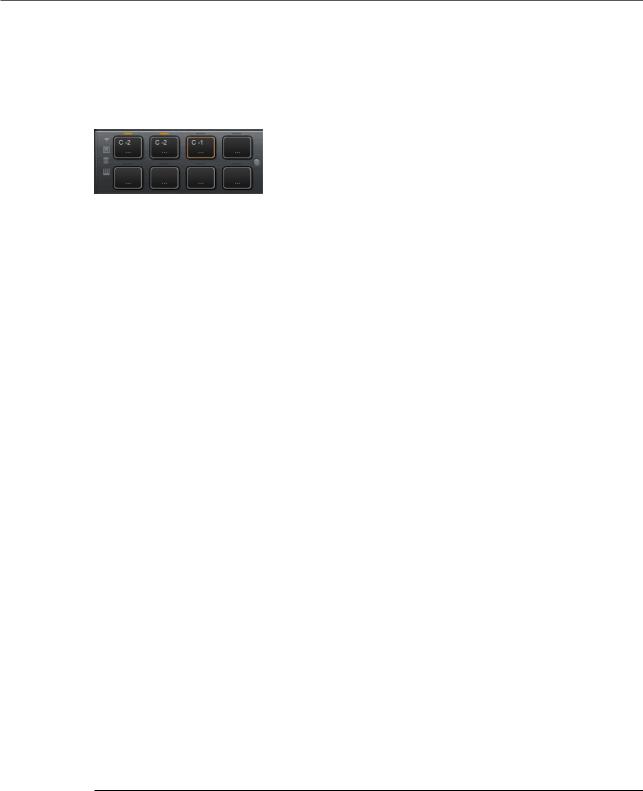
Global Functions and Settings
Trigger Pads
Trigger Pads
You can use the trigger pads to trigger single notes or whole chords and to switch between FlexPhraser variations.
Many of the programs that come with HALion Sonic SE make use of the trigger pads.
If a note or a chord is assigned to a pad, this pad turns orange. If a pad switches between FlexPhraser variations, the line above the pad turns orange.
• To trigger a pad, click on it.
Presets
Pad presets save trigger notes and chord snapshots, but not FlexPhraser snapshots. This means that you can exchange trigger notes and chords by loading presets without loosing your FlexPhraser snapshots.
Bypass
With the Bypass Pads button to the right of the trigger pads, you can bypass the entire pads section. This deactivates any functionality you assigned to the trigger pads.
Assigning Trigger Notes to Pads
You can assign a MIDI note to a pad and trigger the pad by playing this note. To define the trigger note, do one of the following:
•Right-click a pad, open the Assign Trigger Note submenu, and from the further submenus, select the octave and note that you want to assign.
•Open the context menu for a pad, select Learn Trigger Note, and play the note on your MIDI keyboard or click a key on the internal keyboard.
The name of the assigned trigger note is displayed in the top left corner of the pad.
On the internal keyboard, keys that serve as trigger notes are shown in blue. These keys do not play sounds, but trigger the corresponding pads instead.
•To remove a trigger note from a pad, right-click the pad and select Forget Trigger Note.
Assigning Chords or Notes to Trigger Pads
PROCEDURE
1.Right-click a pad and select Snapshot Chord. The pad starts blinking.
2.Do one of the following:
•Play a chord or a single note and then click the pad that is blinking to assign the chord or note to the pad.
17

Global Functions and Settings
Trigger Pads
•Drag a chord event from the chord track of your Steinberg DAW onto a trigger pad. This transfers the corresponding MIDI notes to the pad.
If you drag a chord event onto the internal keyboard first, the corresponding chord is played back. This is useful to verify whether you selected the correct chord.
If you define a chord that contains a key switch, you can trigger the chord with a specific instrument expression.
If you add keys to a chord that also work as trigger notes, they trigger the underlying MIDI note instead of the trigger note.
RESULT
Triggering the pad now plays the chord or note.
Default Trigger Note Settings
Assigned trigger notes are saved with each program to allow for maximum flexibility. However, you can save a fixed set of default trigger notes to reflect an existing hardware setup, for example.
•To specify a default set of trigger notes, set up the trigger notes for all pads, right-click a pad, and select Save Trigger Notes as Default.
•To activate the default trigger note settings, right-click a pad and select Use Default Trigger Notes.
Now, changing programs or multi-programs does not change the trigger notes anymore.
If you deactivate Use Default Trigger Notes, the last set of trigger notes remains active. To return to the trigger notes that were saved with the program, reload the program.
Assigning Key Switches to Trigger Pads
To use the pads for switching between expressions, assign them to the corresponding key switches.
PROCEDURE
•Right-click a pad, select Snapshot Chord, and play the key switch.
Naming Pads
Entering names for pads allows you to get a better overview of their functionality, for example.
PROCEDURE
1.Right-click the pad to open the context menu and select Rename Pad.
2.Enter the new name and press Enter.
18
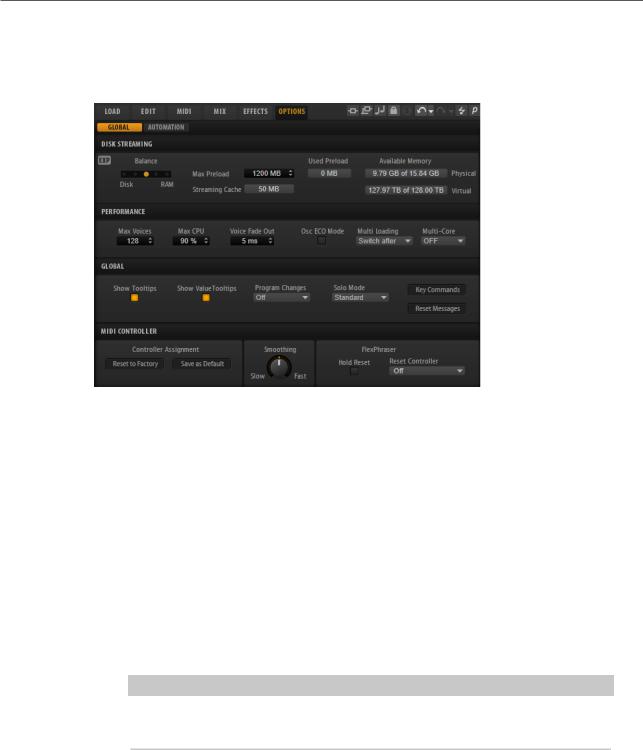
Global Functions and Settings
Options Page
Options Page
The Options page contains global settings regarding performance optimization, global functions, and MIDI controllers.
Disk Streaming Section
Some of the programs come with up to 1 GB of samples. That is a large amount of data and your computer cannot load all samples completely into the RAM, especially if you are using all slots. Therefore, HALion Sonic SE loads only the initial milliseconds of each sample into RAM. You can specify how much RAM should be used and how much HALion Sonic SE should rely on accessing the hard-disk.
Balancing Disk vs. RAM
Use the Balance slider to balance the hard disk versus the RAM usage.
•If you need more RAM for other applications, drag the slider to the left towards the Disk setting.
•If your hard disk is not supplying data fast enough, drag the slider to the right towards the RAM setting.
NOTE
The Disk vs. RAM setting always applies to all plug-in instances. It is not saved with the project. You set it up only once for your computer system.
Used Preload and Available Memory
These displays provide information of the memory load in MB according to the current balance slider setting.
Max Preload
Determines the maximum amount of RAM that HALion Sonic SE uses for preloading samples. In most cases, the default values are sufficient. However, it may become necessary to reduce this value, for example, when working with other applications or plug-ins that require a lot of memory.
19
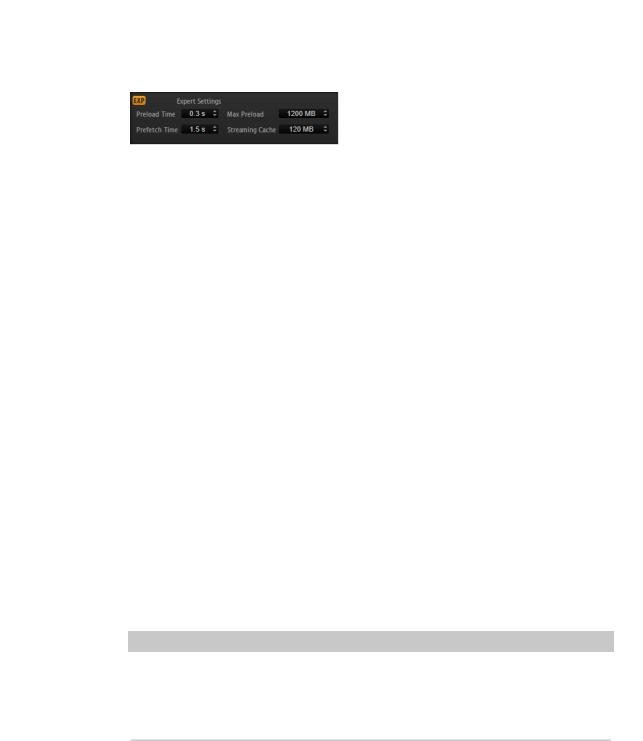
Global Functions and Settings
Options Page
Expert Mode
Activate Expert Mode if you want to adjust the Disk Streaming settings in greater detail.
•Preload Time defines how much of the start of the samples is preloaded into the RAM. Larger values allow for more samples to be triggered in a short time.
•Prefetch Time determines the read-ahead capacity into the RAM while streaming samples for a voice that is playing. Larger values allow for better transfer rates from disk, and usually for more voices. However, this requires larger streaming cache in RAM. If you increase the Prefetch Time, it is recommended to also increase the Streaming Cache.
•Streaming Cache determines the amount of RAM that is reserved for prefetching. The actually needed size depends on the prefetch time, the number of simultaneously streaming voices and the audio format of the samples. For example, higher sample and bit rates need more RAM.
Performance Section
The Performance section contains settings to optimize the overall CPU performance of the plug-in.
Max Voices
Determines the total number of voices that a plug-in instance can play back. As soon as this limit is reached, HALion Sonic SE starts stealing voices.
Max CPU
To avoid clicks from CPU overloads, you can specify a maximum limit for the CPU load of the plug-in instance. HALion Sonic SE steals voices automatically when this limit is exceeded. At a setting of 100 %, this parameter is deactivated.
NOTE
Because of the reaction time of the plug-in, it is possible that you get CPU peaks that exceed the set limit. This can lead to artifacts, such as audio drop-outs. Therefore, it is good practice to set the Max CPU setting at a value a bit lower than actually needed.
Voice Fade Out
Sets the time to fade out voices that need to be stolen because the Max Voices setting or the Max CPU setting have been reached.
Osc ECO Mode
Activate this option to run the oscillators of synth layers in ECO mode. In ECO mode, the oscillators use less CPU at the cost of producing more aliasing at higher pitches. If this option is activated, you can play more voices with synth layers.
20

Global Functions and Settings
Options Page
Multi Loading
Normally, when loading multi-programs, the previous multi is kept in the RAM until the new multi has been completely loaded. Therefore, replacing a large multi by another can lead to RAM overload on 32-bit systems.
•To clear a multi before loading a new one, select Clear before on the popup menu.
Multi-Core
On this pop-up menu, you can specify how many of the available CPU cores of your system can be used by the plug-in. This allows HALion Sonic SE to compute each program on a different core, for example. The best setting here depends on multiple factors, and varies from system to system, and project to project. A good starting point is to set this value to one core less than the available number of cores.
NOTE
If problems occur, reduce the number of cores, or set the pop-up menu to Off and load multiple instances of HALion Sonic SE instead. This way, the host application distributes the work load across the available cores.
Global Section
Here, you find common settings of HALion Sonic SE and the General MIDI mode parameter. NOTE
The settings in this section are not saved with a project, but affect the plug-in as a whole.
Show Tooltips
If this option is activated, a tooltip is shown when you move the mouse over a control.
Show Value Tooltips
If this option is activated, parameters without a value field display their value in a tooltip when you use the corresponding control.
Solo Mode
•In Standard mode, you can solo multiple programs or layers to hear them combined.
•In Exclusive mode, only one program or layer can be soloed at a time.
Program Changes
Determines how HALion Sonic SE handles incoming MIDI program change messages.
•In GM Mode, program change messages are used to switch programs in the slots of the multi program rack.
•Select Off to ignore incoming controller change messages.
21

Global Functions and Settings
Options Page
General MIDI Mode
Select General MIDI Mode to play back MIDI files that have been arranged for General MIDI sound sets. General MIDI mode supports MIDI program change messages and preloads a global chorus and reverb effect on AUX FX 1 and 3 for immediate use.
If General MIDI mode is activated, all loaded programs are removed and the 16 slots are assigned to the 16 MIDI channels. As long as General MIDI mode is active, the 16 MIDI channels on the MIDI page cannot be changed.
The MediaBay sets an instrument set filter and displays only the General MIDI sounds. The MIDI program changes 0–127 refer to the corresponding GM Sound attributes of the MediaBay. This means that you can make any of your sounds part of the General MIDI sound set by setting the GM Sound attribute on the corresponding sound.
NOTE
The General MIDI sounds that come with HALion Sonic SE are optimized for fast loading times. However, larger programs take longer to load.
Key Commands
Opens the Key Commands dialog, where you can view and assign key commands.
Reset Messages
If you click this button, all message dialogs that have been suppressed with the Don't Show Again option are displayed again.
MIDI Controller Section
Controller Assignment
With the two buttons in this section, you can save your customized MIDI controller assignments as default or restore the factory MIDI controller assignments.
NOTE
Save as Default does not include any of the MIDI controller assignments of the AUX FX.
The current MIDI controller mapping is also saved with each project. This way, you can transfer your settings to other systems. The project includes the MIDI controller assignments of the AUX FX as well.
MIDI Controller Smoothing
MIDI controllers have a maximum resolution of 128 steps. This is rather low. Therefore, if you use a MIDI controller as a modulation source in the modulation matrix or to remote-control a quick control, the parameter change may occur in audible steps, causing an effect often referred to as “zipper noise”. To avoid this, HALion Sonic SE provides MIDI controller smoothing, so that parameter changes occur more gradually.
22

Global Functions and Settings
Options Page
•If MIDI controller changes cause audible artifacts, turn the control towards slower settings. This way, MIDI controller changes do not occur immediately, but are spaced over a period of time (in milliseconds).
•If you want more immediate MIDI controller changes, turn the control towards faster settings. Note, however, that this may introduce audible artifacts.
FlexPhraser
Hold Reset sends a global hold reset message to all FlexPhraser modules that are used.
The Reset Controller pop-up menu allows you to assign a dedicated MIDI controller to the Hold Reset button for remote-controlling it.
23

Managing Your Sounds
About Programs, Multis, and Presets
Programs
A program is a complex instrument or sound. Often, a program comes with all necessary components, such as the synthesis part or insert effects.
Multis
HALion Sonic SE is a multitimbral plug-in that can load up to 16 sounds (or programs) and combine them. This combination is called a multi-program, or multi for short. You can use multis to layer several programs or to create split sounds by setting several programs to the same MIDI input channel, for example. However, the most common usage is to create sound sets with different instruments set to individual MIDI channels.
Presets
You can save and load all types of sounds as presets, that is, you can create presets for single programs and for multis.
Loading Programs
HALion Sonic SE can load the program content that comes with Steinberg’s DAWs and VST Sound Instrument Sets, as well as any compatible user content created with HALion 6.
There are several ways to load programs:
•Via drag and drop from the File Explorer/Mac OS Finder
•Via the slot context menu
•By clicking the Load Program button at the right of the slot
NOTE
Programs containing lots of sample data may take some time to load.
RELATED LINKS
Slot Context Menu on page 25
24
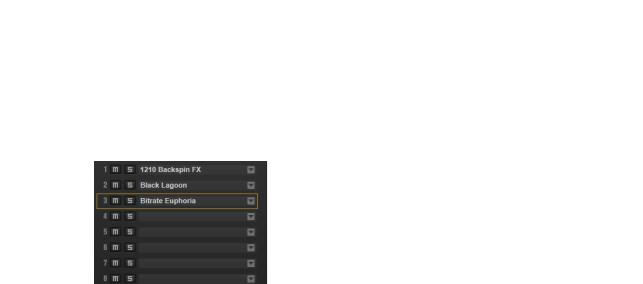
Managing Your Sounds
Slot Rack
Slot Rack
The Slot Rack has 16 slots. Each slot can hold a program, that is, you can work with 16 programs at the same time.
Each slot has a Mute button and a Solo button. You can mute and solo several programs at the same time. The slot number to the left of the slot lights up if incoming MIDI data is detected.
Once a program is loaded in the Slot Rack, it can be played and edited.
Slot Context Menu
The context menu provides a number of functions for managing programs.
Load Program
Opens the program loader. Double-click a program to load it into this slot.
Save Program
Saves the program. If you try to overwrite write-protected factory content, a dialog opens that allows you to save the edited program under a new name.
Save Program As
Allows you to save the program under a new name.
Save All Programs
Allows you to save all programs as a VST preset.
Remove Program
Removes the program from the slot.
Init Program
Loads the Init program. This contains a neutral synth layer.
Revert to Last Saved Program
Discards any changes that you made to the program since the last time it was saved.
Cut Program
Copies the program and removes it from the slot.
Copy Program
Copies the program.
25

Managing Your Sounds
Managing and Loading Files
Paste Program
Pastes the copied program into the slot. If the slot already contains a program, it is replaced.
Rename Program
Allows you to rename the program.
Reset Slot
Resets the slot to the default values.
Reset All Slots
Resets all slots to the default values.
NOTE
You can also cut, copy, and paste programs from one plug-in instance to another.
Managing and Loading Files
You can use the MediaBay to manage, navigate to, and load different file types.
Managing Multis
Multis can load multiple sounds or programs and combine them.
You can use multis to layer several programs or to create split sounds by setting several programs to the same MIDI input channel, for example. However, the most common usage is to create sound sets with different instruments set to individual MIDI channels.
A multi-program contains all plug-in parameters. If you use HALion Sonic SE as a plug-in in a Steinberg DAW, these multis are listed in the Preset Management pop-up menu of the host application. You can drag multis and programs from the MediaBay to a slot in HALion Sonic SE.
If you use HALion Sonic SE as a plug-in in a different host application, you can use the preset functionality from the host application or the multi management features provided by HALion Sonic SE.
Loading Multis
You can load multis in the following ways:
•Open the MediaBay and double-click a multi or drag a multi onto the multi slot.
•Click the Load Multi-Program button in the multi slot to open the Load Multi-Program dialog, select a multi, and click OK.
Renaming Multis
PROCEDURE
•To rename a multi, click in the name field, enter a new name, and press Return.
26

Managing Your Sounds
Managing and Loading Files
Removing Multis
•To remove all programs of the current multi, click the Remove All Programs button on the toolbar of the multi program rack.
Clearing the Plug-In Instance
•To reset the entire plug-in instance to an empty state, right-click the multi loader and select Clear Plug-in Instance from the context menu.
Saving Multis
PROCEDURE
1.Click the Save Multi-Program button.
2.Enter the name of the multi.
3.Assign any attributes that you want to use and click OK.
If the entered name already exists, the Make Unique Name option adds a number suffix to the name of the new multi.
Saving a Multi as Default
•To specify a default multi to be loaded with HALion Sonic SE, use the Save as Default command on the context menu for the multi loader.
Creating Subfolders for User-Defined Multis
You can create subfolders inside the user preset folder to organize presets.
•To create a new folder, click the Create New Folder icon at the top left of the Save Multi-Program dialog.
Navigating Through the Folder Hierarchy
You can move through the folder hierarchy using the three navigation buttons at the top left of the dialog.
These buttons allow you to navigate to the previous or next browse location, or browse the containing folder.
Editing Attributes
You can edit the attribute values that are assigned to the preset.
PROCEDURE
1.Open the Save Multi-Program dialog and navigate to the New Preset Tags section.
2.To edit an attribute, click on a value field and enter the new name or value.
3.Click OK to save the preset.
Managing Files via the MediaBay
The MediaBay functionality can be found on the Load page.
27

Managing Your Sounds
Managing and Loading Files
In the top section of the MediaBay, you specify which sounds to look for. The lower section presents the corresponding results.
•To adjust the size of the two sections, drag the divider at the top of the results list.
Applying Filters
Category Filter
You can filter the results list based on up to 4 filter criteria using the configurable attribute columns. The standard attributes are Category, Sub Category, Style, and Character.
Only the files that match the filter are displayed in the results list.
•To define the filter, click on specific values in the columns.
•To refine the filter, select more values from other columns.
•To select different filter criteria, click the column header and select a different attribute from the submenu.
Content Set Filter
Use the Select Content Set pop-up menu to search a specific content set. By default, the search is performed in all installed content sets.
Results List
The results list shows all files that have been found according to the category filter.
Text Search
In the text search field on the results list toolbar, you can enter text contained in the name or any of the attributes of a preset that you are looking for. The results list is updated immediately and the category search section above shows all categories that contain presets matching the text search.
To reset the text-based result filter, click Clear Search Text next to the search field.
View Filters
The toolbar has three filter buttons that allow you to define which preset types to display: multis, programs, or layers. In the results list, the corresponding icon is shown to the left of the preset name.
Rating Filter
You can limit the results list according to the rating of the presets. Use the rating slider to define the minimum rating.
Content Filters
The content filter buttons allow you to define whether to show all presets, only the factory presets, or only your user presets.
28

Managing Your Sounds
Managing and Loading Files
Columns
The columns show all the attribute values for the presets that match the filters that you set up in the top section.
Set Up Result Columns
Allows you to select which attribute columns to display on the toolbar.
Results Counter
The number of presets that match the filter criteria is displayed at the right of the toolbar.
Configuring the Results List
•To configure which attributes are shown in the results list, click Set up Result Columns in the upper right corner of the results list and activate the corresponding entries. New attributes are added at the right of the list.
•To reorder the columns in the results list, drag the column headers to another position.
•To change the sorting of the list entries, click the column header. The triangle in the column header shows the sorting direction.
Assigning General MIDI Program Change Numbers to Sounds
PROCEDURE
1.In the MediaBay, click Set up Result Columns on the title bar of the lower section.
2.Select Musical > GM Sound.
3.Select the sound to which you want to apply the GM program change number.
4.In the GM Sound column for the sound, select the General MIDI program change number that you want to use.
You can assign the same GM Sound program number several times. If a program number is used more than once, the Rating attribute can be used to decide which program to load.
RESULT
Now, you can use MIDI program change messages to load the assigned sounds into the slot of the corresponding MIDI channel.
29

Managing Your Sounds
Managing and Loading Files
NOTE
Slot 10 ignores any program change messages and keeps the loaded drum set.
Loading Programs into Slots
To load a program into one of the slots of the Slot Rack, you have the following possibilities:
•Select the slot into which you want to load the program, and double-click the program in the results list.
•Drag a program from the results list to an empty space in the Slot Rack to create a new slot.
If you drag it to an existing slot, the current program is replaced.
•Right-click the program and select Load Program into selected Slot from the context menu.
30
